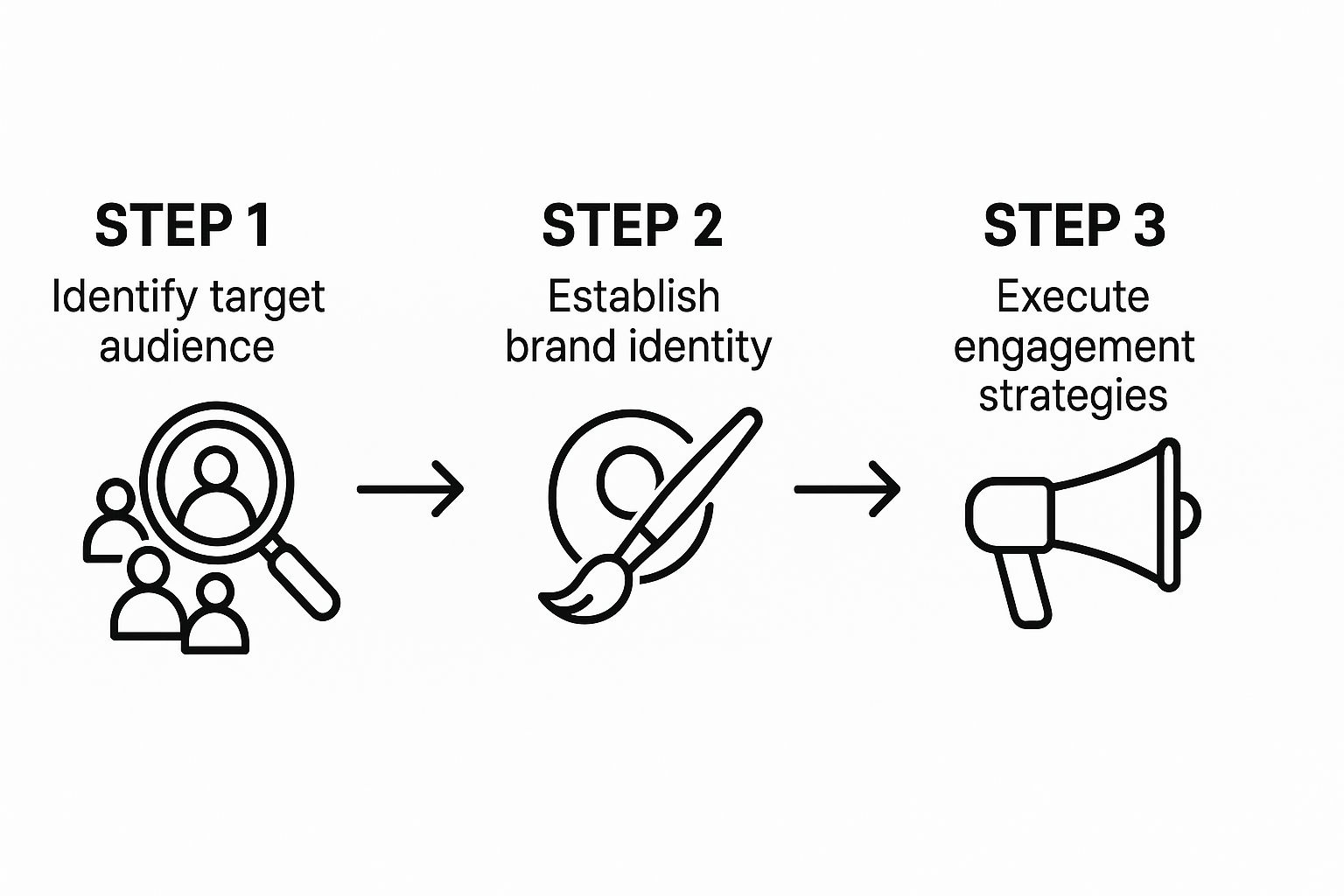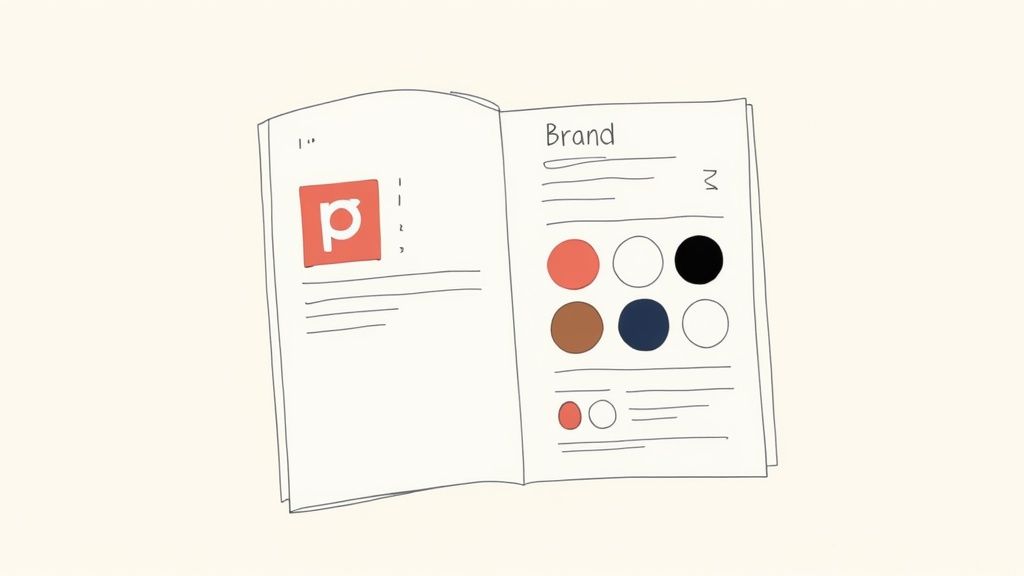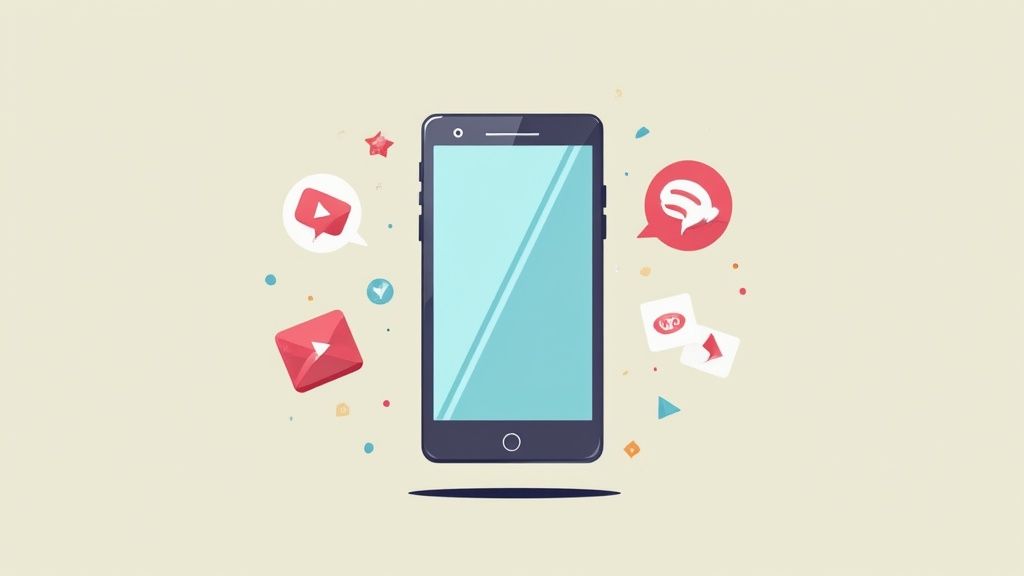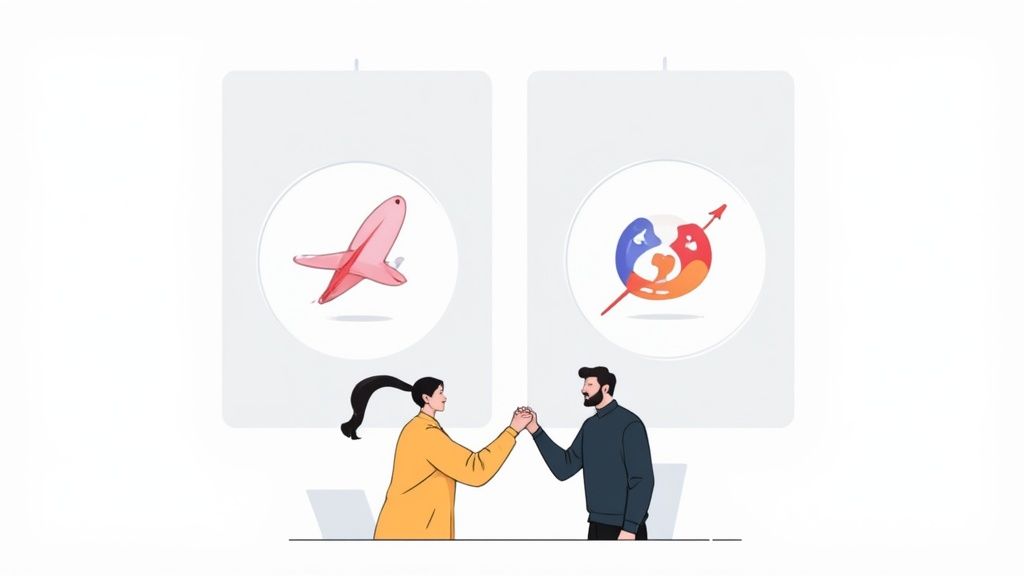How to Build Brand Awareness: Proven Strategies to Grow Your Audience

Building brand awareness is all about creating a memorable identity and showing up consistently where your audience hangs out. It’s a journey that starts with truly understanding who you're talking to and ends with a strategy that makes your brand not just recognizable, but the one people trust and prefer.
Laying the Groundwork for an Authentic Connection
Real brand awareness isn't about being the loudest voice in the room; it's about being heard by the right people. Before a single campaign goes live, the hard work begins: getting to know your audience on a human level. This is where you move past basic demographics and start building a genuine connection.
The goal here is to lay a foundation of trust and recognition. You want to build a brand that people don't just remember, but one they actively choose. This is the stage where you turn deep audience insights into a clear, compelling brand message.
Define Your Audience with Pinpoint Accuracy
You can't build awareness if you're talking to a faceless crowd. It all starts with creating detailed audience personas. Go beyond just age and location—dig into their motivations, their anxieties, and how they behave online. What problems are keeping them up at night? What social media apps are they scrolling through right before bed?
Answering these questions is how you craft messages that actually resonate. To get this right, you really need to do a complete target audience analysis. This process becomes the North Star for every single piece of content you create, ensuring you’re speaking directly to the people who matter most.
The path from identifying your audience to launching your strategy is a clear one, and it all starts with these foundational steps.

This visual really drives home the point that a successful engagement strategy is the final piece of the puzzle, built on the critical groundwork of knowing your audience and defining your brand.
Craft a Memorable and Consistent Brand Identity
Once you have a crystal-clear picture of your audience, it's time to define how your brand will show up in the world. This is about so much more than a logo and some cool colors; it's about nailing down your unique value proposition and developing a brand voice that’s unmistakably you.
Your brand's identity should instantly answer one question for your audience: "Why should I care?" You get there by focusing on a few key things:
- A Unique Value Proposition (UVP): What’s the one clear benefit you offer that no one else does? Is it top-tier quality, unbeatable convenience, or a mission that people can rally behind? Spell it out.
- A Consistent Brand Voice: Decide on your brand's personality. Are you witty and informal, or more authoritative and professional? Whatever you choose, that voice needs to stay the same everywhere—from your website copy to your social media comments.
- Visual Cohesion: Make sure your logo, color palette, and fonts are used uniformly across the board. This visual repetition is what builds that instant, gut-level recognition.
To help you get these core pieces in place, here's a quick checklist to make sure your brand's foundation is solid before you start trying to build awareness on top of it.
Brand Foundation Quick-Start Checklist
Use this checklist to ensure your brand's core elements are defined before you start building awareness.
| Foundation Element | Key Objective | Actionable Tip |
|---|---|---|
| Audience Persona | Deeply understand who you're talking to. | Interview 3-5 existing customers to uncover their real pain points and language. |
| Unique Value Prop (UVP) | Clearly state what makes you different. | Finish this sentence: "We help [audience] do [benefit] by [unique feature]." |
| Brand Voice & Tone | Define your brand's personality. | Create a simple "We are... We are not..." chart (e.g., "We are witty, not sarcastic"). |
| Visual Identity | Ensure visual consistency everywhere. | Develop a one-page brand style guide with your logo, color codes, and fonts. |
This checklist isn't just a to-do list; it's your blueprint for building a brand that feels cohesive and trustworthy from day one.
And that consistency is the bedrock of trust. Think about it: 81% of consumers need to trust a brand before they'll even think about buying from them. Social media just amplifies this—a whopping 77% of consumers say they prefer buying from brands they follow online.
Your brand isn’t what you say it is; it’s what your audience perceives it to be. Consistency in your message, voice, and visuals is what builds the trust you need to shape that perception.
A powerful way to build this authentic connection is by letting your audience do the talking. A comprehensive guide to user-generated content marketing can show you how to turn happy customers into your most passionate advocates. By focusing on these fundamentals, you’re not just getting ready to launch a campaign; you’re building a brand people will actually want to know.
Crafting Content People Actually Want to Share
Once you've got your brand's foundation sorted, it's time to bring your story to life with content. This isn’t about just checking boxes on a content calendar with generic posts. It’s about creating genuinely helpful, interesting experiences that solve real problems and build an actual connection with your audience.
Think of it this way: great content is the engine for brand awareness. It’s what turns people who are just scrolling by into active, engaged followers.
The secret is to start thinking more like a publisher and less like a marketer. Every single thing you create, from a quick carousel on LinkedIn to a deep-dive guide, needs to offer real, tangible value. The goal is to become the go-to resource people in your niche trust and rely on. When you make that mental shift, your content stops feeling like an ad and starts feeling like a conversation.
Map Your Content to the Customer Journey
People need different things at different times. Someone just figuring out they have a problem needs a completely different type of information than someone who's got their credit card out, ready to buy. When you match your content to these specific stages, your message actually lands and has an impact.
For instance, someone in the early Awareness stage is probably looking for broad, educational content. This is the perfect place for short-form videos, insightful LinkedIn carousels (which you can whip up with a tool like Lumeo), or helpful blog posts. You're introducing your brand as an expert who's there to help, not just to sell.
As they dig deeper and enter the Consideration stage, they're going to need more substance. This is your chance to offer things like:
- Detailed How-To Guides: Walk them step-by-step through solving a problem they're actively wrestling with.
- Comparison Posts: Don't be afraid to honestly compare your approach to others. That kind of transparency builds serious trust.
- Case Studies or User Stories: Nothing is more powerful than social proof. Show them how real people just like them found success with your help.
Finally, when they reach the Decision stage, your content needs to give them that final nudge of confidence. Think customer testimonials, product demos, or crystal-clear messaging that spells out the benefits. You want to make choosing you feel like the most obvious, easy decision they could make.
Tell Stories That Stick
Facts and data are great for informing, but stories are what people actually remember and feel compelled to share. Storytelling is easily your most powerful tool for forging an emotional bond that goes way beyond a simple transaction. It’s how you let your brand's personality and values shine through in a way that feels human.
And a great brand story doesn’t need to be some grand, sweeping epic. You can find powerful stories in the small, everyday moments:
- The real story of why you started your business and what problem you were passionate about solving.
- A customer’s journey to success, told in their own words.
- A behind-the-scenes peek at your team and the culture that makes you tick.
Imagine a local coffee shop. Instead of just posting pictures of lattes, they could create a carousel series that follows their coffee beans from a specific farm in Colombia, introducing the farmers and their community. Suddenly, a simple cup of coffee has a soul and a story, making it infinitely more memorable.
The fastest way to build brand awareness is to create content that people don't just see, but feel. A story well told can turn a product into a purpose and a customer into an advocate.
This isn't just fluffy stuff—it directly impacts the bottom line. Research shows that 50% of consumers are more likely to buy from brands they recognize. Visual storytelling is especially powerful; a whopping 64% of consumers say they've made a purchase after watching a brand's video. You can dig into more of these compelling branding stats to see the clear line between engaging content and business results.
Brainstorm Topics That Solve Real Problems
The absolute best content ideas come from listening, not from a brainstorm session in a conference room. Your audience is constantly telling you what they need—you just have to know where to look. Instead of asking, "What can we post about today?" start asking, "What problems can we solve for our audience?"
Here are a few proven ways to find topics that actually matter:
- "People Also Ask" on Google: This is a goldmine. Type a core keyword from your industry into Google and scroll down. That "People Also Ask" box is a direct feed of the exact questions your audience is asking. Answer them.
- Social Listening: Keep an eye on hashtags, keywords, and what people are saying in the comments of your competitors' posts on platforms like LinkedIn, Instagram, and X. What are the recurring frustrations? What questions pop up over and over?
- Talk to Your Support Team: Your customer service or success team is on the front lines every single day. They know the most common questions, hurdles, and challenges your customers face better than anyone. Every one of those is a content idea waiting to happen.
When you ground your content strategy in solving real problems and telling memorable stories, you're not just creating posts that attract eyeballs. You're building a library of value that builds trust, gets shared, and solidifies your brand in the minds of the people who matter most.
Choosing Where to Tell Your Brand's Story
Creating killer content is only half the job. If nobody sees it, does it even exist? In a world of infinite platforms, the temptation is to be everywhere at once. But that’s a fast track to burnout and getting mediocre results across the board. The smarter play for building real brand awareness is a focused, strategic distribution plan that meets your audience right where they are.
Instead of stretching your team and budget thin, the real goal is to pinpoint the specific channels where your target audience actually hangs out and pays attention. A solid distribution strategy makes every single piece of content work harder for you, building the kind of frequency and recognition that makes your brand stick.
Pinpoint Your Core Channels
The first step isn't to frantically create a profile on every hot new platform. It’s to go back to your audience personas and figure out their digital habitats. Where do they turn for industry news, for entertainment, or for professional growth?
Are you trying to reach decision-makers who live on LinkedIn, or a younger crowd creating and consuming short-form video on TikTok and Instagram? Knowing this stops you from wasting time crafting the perfect message for an empty room. Dig into the analytics you already have. See where your best traffic comes from, and double down on that channel first.
For example, a B2B software company might notice that while Instagram gets them a few likes, LinkedIn is driving 90% of their demo requests. That’s not a hint; it’s a giant flashing sign. It tells them to prioritize LinkedIn, maybe by using Lumeo to create slick carousels that break down complex software features into simple, digestible slides. The key is to choose depth over breadth every time.
Master Organic and Paid Strategies
Once you’ve locked in your core channels, you can build a multi-pronged attack that combines long-term growth with a few quick wins. These two approaches aren't an either/or—they work best in tandem.
Search Engine Optimization (SEO): Think of SEO as your long-game engine for brand awareness. When you create content that directly answers the questions your audience is typing into Google, you build a sustainable source of organic traffic. This isn't just about stuffing keywords; it’s about becoming the trusted authority people find when they genuinely need help.
Social Media Engagement: Platforms like LinkedIn, X, and Instagram are conversation starters. They're perfect for building a community. The trick is to create content that feels native to each platform’s unique culture—that means thought-provoking text posts on LinkedIn, quick visual tutorials for Instagram Reels, and joining timely conversations on X.
Paid Advertising: When you need to put your foot on the gas, paid ads on social or search can give you that immediate boost. You can get incredibly specific, targeting people by demographics, interests, and behaviors to make sure your content lands in front of the right eyeballs, fast.
A truly cohesive plan uses all three. You could run a targeted ad campaign promoting a huge pillar blog post that’s also optimized for search, driving both immediate and long-term traffic. To get deeper into the nuts and bolts of this, check out our complete guide on building a powerful content distribution strategy.
Leverage Partnerships and Collaborations
You don’t have to build your entire audience from scratch. One of the fastest ways to build credibility and expand your reach is by tapping into existing communities through smart partnerships. This lets you introduce your brand's story to new, relevant audiences who are already primed to be interested in what you have to say.
Think about other brands that serve a similar audience but aren't direct competitors. A financial planning app could team up with a career coaching service, for instance.
Here are a few high-impact ideas to get you started:
- Guest Appearances: Getting featured on industry podcasts or YouTube channels instantly puts you in front of an engaged audience that already trusts the host.
- Co-Marketing Campaigns: Partner with a complementary brand to create a joint webinar, co-author an in-depth guide, or run a collaborative social media giveaway.
- Influencer Collaborations: Find authentic creators in your niche whose values line up with yours. A partnership with a sharp micro-influencer can often feel more genuine and drive better results than one with a massive, generic account.
You can even use a tool like Google Trends to spot rising topics or creators in your niche who are gaining momentum.

This screenshot comparing search interest shows you what topics are really hitting home with audiences right now, helping you find relevant partners for your next campaign.
The most effective distribution isn't about blasting your message everywhere. It's about creating a series of intentional, valuable touchpoints that reinforce your brand's message across a few carefully selected channels.
By focusing your efforts, blending organic and paid tactics, and being smart about partnerships, you create a powerful, cohesive strategy. This is how you ensure your exceptional content finally finds the audience it deserves, turning those first views into lasting brand recognition.
Turning Followers Into a Thriving Community

Let's be real: sustainable brand awareness is built on relationships, not just reach. A huge follower count might look impressive, but it doesn't mean much if those followers are just passively scrolling by. The real magic happens when you cultivate a genuine community of advocates who feel like they truly belong with your brand.
This is a fundamental mindset shift—from just broadcasting your message to actually building a community. It’s what separates the brands that fizzle out from the ones that last. You have to create a two-way street where your audience feels seen, heard, and valued. When people feel like they’re part of something special, they don’t just buy from you; they become your biggest champions.
Spark Meaningful Conversations on Social Media
Think of your social media channels less like a billboard and more like your local coffee shop. It's a place for connection and conversation, not just for shouting announcements into the void. The first step is simple: stop talking at your audience and start talking with them.
This means going way beyond surface-level stuff like likes and basic shares. Your content needs to be a conversation starter. For instance, instead of just posting a slick photo of your product, ask a question that invites people to share personal stories or opinions. A fitness apparel brand could ask, "What's the one workout song that gets you hyped every single time?"
When you actively listen to the feedback and jump into the discussions you start, you show that there are real people behind the logo. It’s a simple act, but it builds a ton of trust and makes your followers feel like they're active participants in your brand's journey.
Launch User-Generated Content Campaigns
One of the most powerful ways to build a community is to hand the microphone to your audience and let them become the storytellers. User-generated content (UGC) campaigns turn your customers into co-creators, which fosters a deep sense of ownership and belonging. Honestly, when someone's content gets featured by a brand they love, it creates a powerful emotional bond.
And a UGC campaign doesn't have to be some massive, complicated undertaking. It can be as simple as creating a unique hashtag and encouraging customers to share photos of themselves using your product.
Consider giving one of these approaches a try:
- Contest-Based Campaigns: Offer a prize for the most creative photo or video that features your product. This gamifies the whole experience and gives people a clear incentive to join in.
- Community Showcase: Make it a regular thing to feature the best customer photos on your social media feeds or website. A simple "Customer Spotlight" can make someone's day and make them feel incredibly valued.
- Themed Challenges: Kick off a weekly or monthly theme that encourages a specific type of submission. This keeps the content fresh and the community engaged over the long haul.
When your audience starts creating content for you, brand awareness is no longer just your job—it becomes a shared mission. This is the ultimate form of social proof, showing potential customers that real people love and use what you offer.
Reframe Your Email Marketing
So many brands see email marketing as just a sales tool, but it's one of the most underrated community-building platforms you have. Unlike the public square of social media, email is a direct, personal line of communication to your most dedicated followers. Use it to make them feel like insiders.
Instead of just blasting out promotions, treat your email list like a VIP club. Share content and opportunities they can’t get anywhere else. This nurtures a feeling of exclusivity and appreciation, turning subscribers into some of your most loyal fans.
Here’s how you can use email to build that community feel:
- Share Behind-the-Scenes Glimpses: Give your subscribers a peek behind the curtain. Introduce your team members, share the story of how a new product came to be, or show a "day in the life" at your company.
- Offer Exclusive Content: Give your email list early access to blog posts, first dibs on new products, or special guides and resources that aren't available to the general public.
- Spotlight Community Members: Feature a loyal customer or share a compelling story from someone in your community. This reinforces the idea that your brand is all about the people it serves.
By transforming passive followers into an active community, you're building a powerful, self-sustaining engine for brand awareness. These advocates will share your story more authentically and persuasively than any ad campaign ever could, creating a brand that truly belongs to its people.
Scaling Your Brand for Local and Global Reach

As your brand starts to get noticed, the very strategies that got you here will need a serious rethink. The magic that works for a local crowd can easily get lost in translation when you go global, and the reverse is just as true.
Scaling your brand awareness is all about striking a delicate balance. You need to hold on to your core identity while tweaking your message so it actually connects with people in different places.
Think of yourself as both a neighborhood champion and a global citizen. Your brand's mission, its values, its personality—that stuff is non-negotiable. But how you deliver that message, from the visuals you choose to the campaigns you run, has to be flexible. It's about showing respect for cultural nuances and building real, authentic connections, no matter where your audience lives.
Winning Over Your Local Market
If your brand is laser-focused on a specific geographic area, the real win comes from weaving yourself into the very fabric of the community. This is so much more than just running a few generic digital ads. It's about becoming a trusted, familiar name people associate with their own neighborhood.
This is where a hyperlocal strategy really pays off. Your inside knowledge of local culture, events, and what people care about is your biggest weapon. You can forge powerful connections that bigger, more detached brands could only dream of.
Here are a few powerful ways to get it done:
- Sponsor Neighborhood Events: Get your name on a little league jersey, a farmers' market stall, or a community festival. It puts your brand right in front of an engaged local audience in a genuinely positive light.
- Partner with Other Local Businesses: Find a non-competing business that serves the same people you do and team up. A local café and a nearby bookstore could co-host an event, cross-promoting to each other's loyal customers. It's a win-win.
- Host Community-Centric Workshops: Offer free, valuable workshops that solve a real local problem. This positions you as a helpful resource, not just another company trying to sell something.
Tapping into local pride is an incredibly powerful way to build brand awareness. People want to support businesses that are invested in their community, and that creates a foundation of loyalty that's tough for outside competitors to crack.
Expanding Your Reach Globally
Taking your brand international is a whole different ballgame. A one-size-fits-all approach is practically guaranteed to fail. What’s funny in one culture might be downright offensive in another, and visuals that hit home in one region could be completely misunderstood somewhere else.
Success hinges on doing your homework and committing to genuine localization.
This is about adapting your content, not just translating it word-for-word. It all starts with understanding regional trends, consumer values, and how people prefer to communicate. That research will shape everything from your social media campaigns to your product positioning, making sure your brand feels native, not like a foreign intruder.
This is more important than ever. A recent study found that 47% of consumers worldwide see locally owned companies as important, which puts real pressure on global brands to get their local approach right. You can read the full insights on the state of the consumer to see just how deep this trend runs.
To make sure your brand connects, you'll need to adapt your strategy:
- Do Your Cultural Homework: Before you launch anything, dig into local customs, holidays, humor, and social etiquette.
- Adapt Your Visuals and Messaging: Make sure your images and the words you use are culturally appropriate and actually mean something to the local audience.
- Localize Your Content Formats: Figure out which platforms and content types are popular in each region. You might find that a carousel you built for LinkedIn can be a huge hit for a totally different audience on another platform. Our guide on proven content repurposing strategies is packed with ideas on how to make your assets work harder.
Your Brand Awareness Questions Answered
Even when you've got a great strategy mapped out, questions always pop up. It's just part of the process of building a memorable brand. Let's tackle some of the most common hurdles I see people run into, so you can keep moving forward with confidence.
How Much Should I Budget for Brand Awareness?
Ah, the million-dollar question. The honest answer? It's different for everyone. Your budget really hinges on your industry, your specific goals, and how fast you’re trying to grow. Don’t just pull a number out of thin air.
A solid rule of thumb for small to mid-sized businesses is to set aside 5-10% of your total revenue for marketing. In the early days, a good chunk of that should go directly toward awareness-building activities.
The trick is to see this as an investment, not just another line item expense. Start with a budget you're comfortable with, focusing your efforts on one or two key channels you've already identified. Once you start seeing what works, you can start scaling up your spending with real data to back your decisions.
What Is the Difference Between Brand Awareness and Lead Generation?
This is a big one, and it’s a distinction that trips a lot of people up. They work together, but they have very different jobs.
- Brand Awareness is all about the top of your funnel. The goal here is simple: familiarity. You're introducing people to who you are and what you're all about, creating a positive vibe long before they even think about buying.
- Lead Generation comes into play further down the funnel. Its job is to capture contact info from people who already know who you are. You’re giving them a reason to take a specific action, like downloading a guide or signing up for a webinar.
Think of it this way: brand awareness is getting invited to the party. Lead generation is getting someone's phone number while you're there. You can't really do the second one without the first.
How Do I Measure the ROI of Brand Awareness?
Measuring the return on awareness campaigns can feel a bit fuzzy. It’s not as straightforward as a sales campaign where you can draw a direct line from an ad to a purchase. Instead, you need to look at a handful of key metrics over time to spot the upward trend.
I recommend focusing on these KPIs:
- Direct Website Traffic: Are more people typing your URL straight into their browser? That’s a fantastic sign that your name is sticking.
- Branded Search Volume: Use a tool like Google Search Console to see if more people are specifically searching for your company or product names.
- Social Media Reach and Engagement: Keep an eye on your impressions (how many people see your stuff) and engagement rates. A steady climb shows your message is spreading.
- Mentions and Share of Voice: Track how often your brand gets mentioned online compared to your competitors.
The real ROI of brand awareness isn't just about quick sales. It’s about building brand equity—that long-term value that makes customers pick you over someone else, even if you cost a little more. It's the trust that fuels real, sustainable growth.
How Long Does It Take to Build Brand Awareness?
Patience is key here. Building genuine brand awareness is a marathon, not a sprint. There's no on/off switch. For most businesses, you'll need to put in consistent effort for 6 to 12 months before you start to see truly meaningful results in your metrics.
Consistency is your best friend. Showing up regularly on your chosen channels with valuable content is what builds the familiarity and trust you're after. If you try to do too much at once, you’ll just burn out, and your message will get muddled.
If you want to go even deeper on setting realistic timelines and expectations, check out a comprehensive guide to building brand awareness. It's a great resource for getting the fundamentals right.
Stay patient, stick with your plan, and keep giving your audience real value. The awareness will come.
Ready to turn your best content into attention-grabbing carousels that build real brand awareness? With Lumeo, you can transform articles, videos, and even single ideas into beautiful, shareable assets in minutes. Start creating for free today at https://lumeo.me and see what your content can really do.